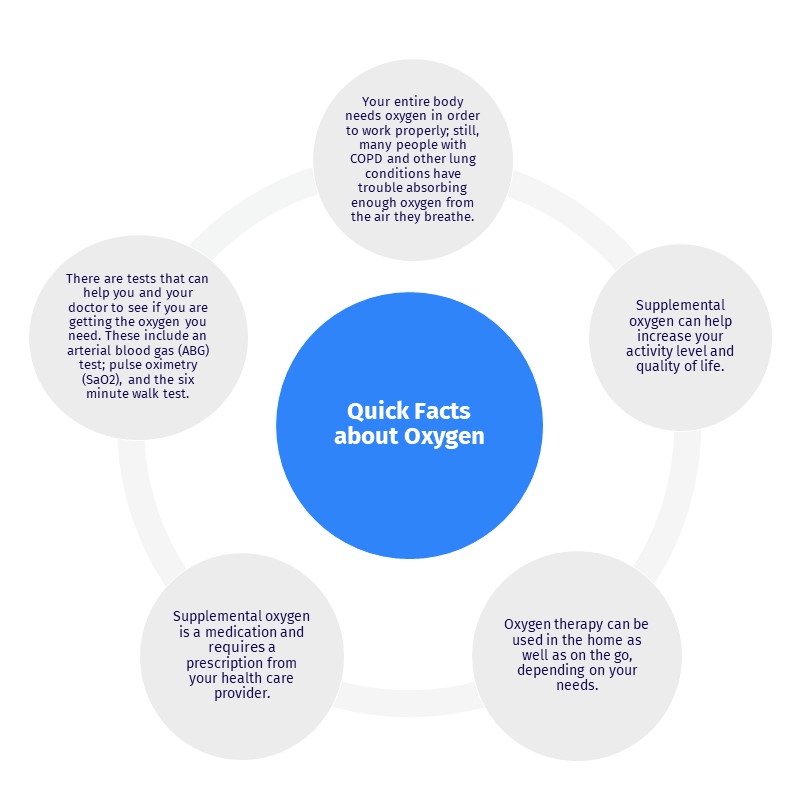
Supplemental oxygen is a treatment that can increase survival and improve the quality of life for many patients with cardiopulmonary disease. It is recommended for patients with chronic hypoxemia at rest or on exertion, according to the ATS Guidelines. There are deficits in supplemental oxygen indications, administration, patient adherence as well as large knowledge and prescription variability among providers. Patients requiring supplemental oxygen often have multiple morbidities and need complex treatments at home (polypharmacy, self-treatment devices, biopsychosocial needs) and need multiple self-management strategies to ensure they adhere to their oxygen prescription. The reorganization of services for more patient-centered and efficient care in an integrated care scenario is needed.
The goals of supplemental oxygen therapy (oxygen used outside of the hospital or acute care setting) is to reverse hypoxemia, prevent cardiac complications of chronic low oxygen levels, decrease breathlessness especially with activity and, hopefully, improve mobility and quality of life. Unfortunately, oxygen therapy impacts caregivers and family, and includes substantial financial challenges to navigate. Advocating for one’s oxygen services requires knowledge and persistence, and a strong collaborative relationship with their health care team.
Portable oxygen devices should be matched to the patient’s physiologic needs (flow rates) as well as lifestyle (hours outside the home, work, stairs, etc…). Portable options are either: a) compressed gas metal cannisters in varying sizes, b) portable oxygen concentrators (POCs) that extract oxygen from the surrounding air, also in a variety of sizes and flow capacities from 3-22 lbs., or as c) liquid oxygen (LOX) that has been super-cooled, provides high flow, and is dispensed by the patient filling containers at home from a main tank. LOX is rarely available in the US since the onset of Competitive Bidding around 2013 and decreased financial reimbursement to Durable Medical Equipment companies (DMEs). Advocating for portability (which means mobility) is complicated by varying supply shortages of both POCs and metal canisters. High flow oxygen users (4 L/min or higher on continuous flow-CF) are the most impacted because POCs usually provide only ‘pulse-flow’ on settings of 1-4, and don’t provide more than 3 L/min. on CF thus relegating high flow oxygen users to large and heavy ‘E’ tanks with trolleys.
Advocacy begins with understanding equipment options and documenting not only required flow rates, but also the number of hours/week that portable devices are required. ATS has worked with the ALA, CHEST, the Pulmonary Fibrosis Foundation, the AARC and many others to solicit patient stories and insurance denials illustrating the significant barriers to receiving adequate portable oxygen. The collection of these documents was invaluable in moving advocacy efforts forward towards drafting legislative language that will demand basic quality metrics to be met in a “4 Pillars Document”. This will include a patient “Bill of Rights” addressing what minimal standards supplemental oxygen users should expect.
Lastly, included in advocacy efforts are the critical movement by patients to demand an active and mobile lifestyle through funding the development of lightweight, high flow, FAA approved, long lasting, portable oxygen devices. Patient-driven efforts resulted in a SBIR-funded grant and others are in process. Bioengineers have collaborated with patients and clinicians to develop devices that will ‘auto titrate’ and adjust oxygen flow based on oxygen saturations during rest and exertion thus automatically increasing flow during activity and turning oxygen flow down when at rest.
There are outstanding patient education materials available through the ATS, ALA, CHEST, LAM, COPD, Pulmonary Fibrosis foundations, and many other PAR organizations, to arm patients with the information needed for them to knowledgeably interact with their care team and with DMEs to advocate for themselves to optimize their oxygen therapy.




